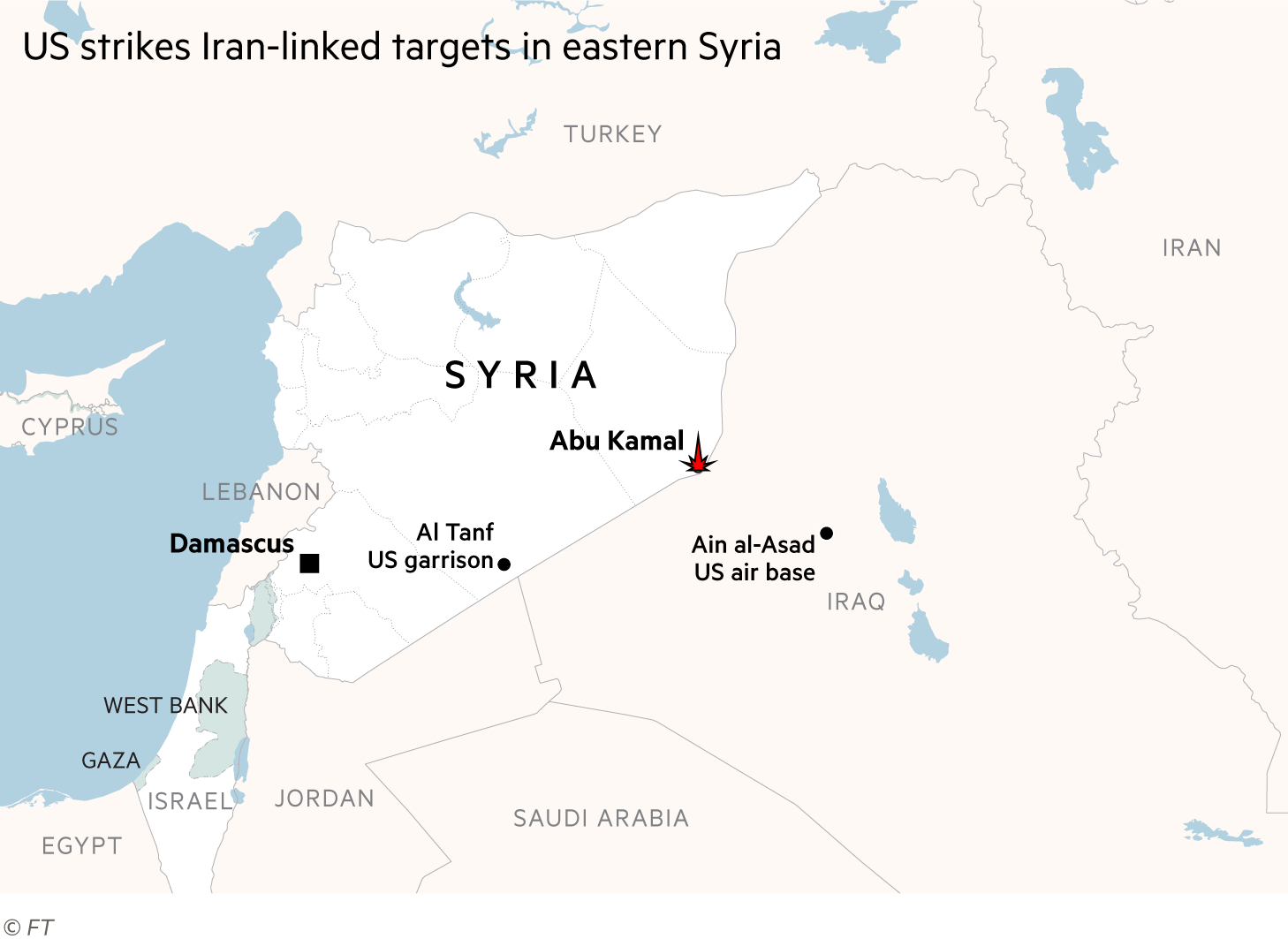Unlock the Editor’s Digest for free
Roula Khalaf, Editor of the FT, selects her favourite stories in this weekly newsletter.
The US military struck two facilities in eastern Syria that it identified as linked to Iran-backed militias, defence secretary Lloyd Austin said, following more than a dozen attacks on American forces in the region in recent weeks.
US officials framed the strikes as self-defence, but the action, the first since war broke out between the Palestinian militant group Hamas and Israel this month, underscores the risk of a spillover conflict across the region as Israel prepares for a widely expected ground operation in Gaza.
The strikes followed 19 rocket and drone attacks on US forces and bases such as Ain al-Asad and Al Tanf in Iraq and Syria since October 17, which have injured 21 service members. One US contractor died from a heart attack while running to shelter.
Austin described the strikes as “narrowly tailored” and defensive, aimed at protecting US forces in Iraq and Syria.
“These precision self-defence strikes are a response to a series of ongoing and mostly unsuccessful attacks against US personnel in Iraq and Syria by Iranian-backed militia groups,” he said.

Charles Michel, president of the European Council, said on Friday morning that EU leaders were worried that Iran could be drawn into a wider Middle East conflict sparked by the Israel-Hamas war “either directly or through proxies”, and that this would “ make the situation more difficult”.
“We are all aware that the situation is extremely dangerous for the region and the world,” said Michel, who speaks on behalf of the EU’s 27 leaders.
The US strikes in eastern Syria came as Israel stepped up preparations for a ground offensive in Gaza intended to destroy Hamas and end its rule in the enclave, after its militants carried out the deadliest-ever attack on Israeli territory earlier this month, killing 1,400 people.
Israeli forces said they had conducted a “targeted raid” inside the Palestinian enclave on Thursday night for the second night running. The raid involved ground forces, fighter jets and drones and took place in the centre of the Gaza Strip, with Israeli aircraft and artillery striking what the military said were Hamas targets in the Shuja’iyya area and elsewhere.
Israeli prime minister Benjamin Netanyahu has been under pressure over his war plans, with government hardliners demanding a more aggressive response to Hamas’s assault while other voices, including in western capitals, urge a delay to the expected ground operation in Gaza.
Militants in Gaza launched a volley of rockets at Israel on Friday. Israeli paramedics said that three people had been injured by one rocket strike in Tel Aviv.
The US has asked Israel to hold off from a ground offensive in Gaza so it can deploy air defence systems to the region and allow aid into the strip, which is facing a humanitarian catastrophe.
Philippe Lazzarini, the head of UNRWA, the UN’s aid agency for Palestinians, said on Friday the last public services and civil order in the territory were “collapsing”, while the streets were overflowing with sewage.
“Our aid operation is crumbling and for the first time ever, [UN staff] report that now people are hungry,” Lazzarini said, adding that the small aid convoys permitted to enter Gaza were “crumbs that will not make a difference to 2mn people”.
More than 7,000 people have been killed in Gaza in Israel’s bombardment, according to Palestinian officials. More than 1.4mn have been displaced and 641,000 are sheltering in UN-designated emergency facilities, according to UNRWA.
The Gaza health ministry on Thursday night released the names and ID numbers of the Palestinians killed during the Israeli air strikes after President Joe Biden and Israeli officials questioned the figures.
Negotiations to free hostages seized by Hamas in its assault three weeks ago are also ongoing.
Israel-Hamas war
The US strikes in Syria show the Biden administration’s effort to deter Iran from targeting US forces in the region while avoiding further inflaming a conflict between Israel and Hamas, which is backed by Tehran.
The facilities near Abu Kamal in Syria were used by Iran’s Islamic Revolutionary Guard Corps and affiliated groups, US defence officials said. One was a weapons storage area and the other an ammunition storage area. Two American F-16s carried out the strikes on Friday morning.
“We do not seek to widen the conflict nor escalate it,” said a senior US defence official. “Our desire is for Iran’s most senior leaders to direct their proxies and militias to cease these attacks on US personnel in Iraq and Syria.”
Washington is strengthening its troop presence and air defences in the Middle East. Since Hamas launched a surprise assault on Israel on October 7, the US has sent 2,000 Marines to the region and deployed two carrier strike groups to deter Iran.
There are 900 US troops in Syria and 2,500 in Iraq assisting local forces fighting the Islamist group Isis.
The Pentagon said on Thursday that it would send or had sent another 900 troops to the region, including personnel to operate air defence systems.
The strikes in Syria were “separate and distinct from the ongoing conflict between Israel and Hamas, and do not constitute a shift in our approach to the Israel-Hamas conflict”, Austin said.
“We continue to urge all state and non-state entities not to take action that would escalate into a broader regional conflict.”
The US last struck Iran-linked targets in north-east Syria in late March, after an attack on an American base that resulted in the death of a contractor, the senior military official said.
Additional reporting by John Reed in Jerusalem and Henry Foy in Brussels


